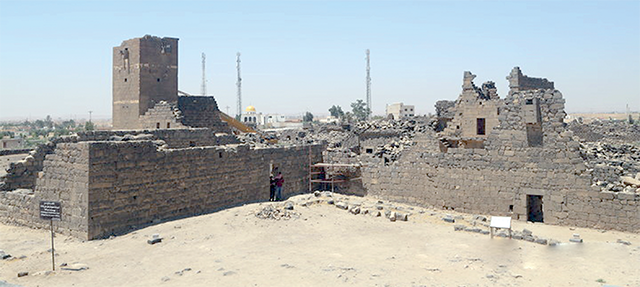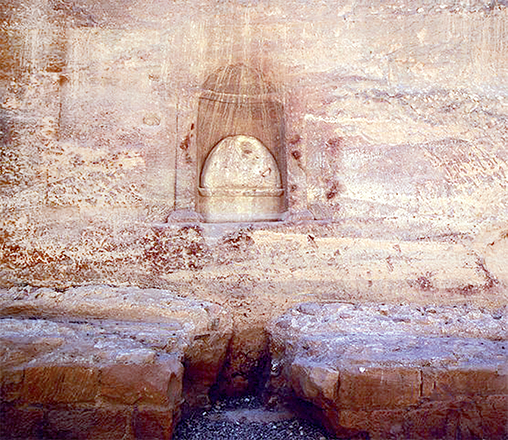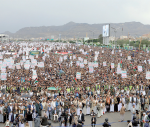You are here
Unveiling the historical layers of Umm Al Jamal: A crossroads of Nabataean, Roman, Islamic eras
By Saeb Rawashdeh - Nov 20,2023 - Last updated at Nov 20,2023

A barracks at Umm Al Jamal, a site located near Mafraq that has a history of occupation from the Nabataean period (Photo courtesy of ACOR)
AMMAN — Located near Mafraq, Umm Al Jamal is another ancient Nabataean site that has continuous occupation during Roman, Byzantine and Islamic periods. Placed as an intersection between cultures, regions and empires, Umm Al Jamal is a cross-current of a rich variety of economic, political and religious practices. Population of Umm Al Jamal was influenced by the Nabataean and later Roman religious concepts, although they manage to preserve a local culture.
“The town became ‘Nabataeanised’ as later kings added the exploitation of the agricultural terrain of the southern Hauran to their economic interests, and made Bostra the administrative centre of this northern Nabataea during the reigns of Aretas IV, Malik II and Rabbel II,” noted a late Canadian researched Bert De Vris, adding that in terms of power politics expansion to the north was triggered by a protracted power struggle over the region with the Herodian Tetrarchic rulers (the two Agrippas and Philip).
Northern part of Huran was incorporated into the Roman Syria, while the southern part became part of the Roman province of Arabia, after the Nabatean state was occupied by Romans in 106AD.
In the political constelation, Umm Al Jamal was a satellite of Bosra must be seen as a satellite village of Bostra.
While local and Nabataean elements of cultural identity did not disappear, the Roman veneer imposed on this is most evident in several Latin inscriptions indicating the presence of Roman imperial authorities, De Vris said, adding that inscriptions discovered at the site mentioned co-rulers, emperors Marcus Aurelius and Commodus and the construction dedication of an unidentified burgus in the co-regency of Valentinian, Valens and Gratian in AD 371.
“This presupposition starts in the general perspective that the religious impact of Hellenisation throughout the entire era from Alexander to Constantine remained superficial and that religion retained its Near Eastern character,” Professor Emeritus De Vris claimed.
Three major gods from the pagan phase of Umm Al Jamal are Dushara Arra, the God Solmos and Holy Zeus Epekoos (who listens).
“All this evidence appears to substantiate that the god Doushara Aarra on the cult-stone dedication at Umm Al Jamal, is meant to be the specific manifestation of this deity in his cult centre at Bostra. Doushara continued as the god of Bostra while it was the capital of the Roman province of Arabia. Coins from Bostra still depict Doushara as its deityduring the reign of Commodus [177AD-192 AD],” the historian said.
At Umm Al Jamal, the main reference to god Solmosis a dedication inscription that is written rather sloppily inside the cartouche and the last two words spill over onto the molding below it.
“The inscriber’s skill clearly was not up to the same high standard as that of the stone mason, and it was dedicated in reverence to the god Solmos,” De Vris said.
A dedication to Holy Zeus Who Listens is on the die of a small altar found by Littmann “in the courtyard of a house to the east of the so-called ‘Barracks’ of which only the top half is preserved so that all but the first letter of the name of the devotee is missing dedication inscriptions throughout Greater Syria”.
“While some of these may refer to the Greek god of Olympus, most instances cover the identity of a variety of local and regional deities, whose degree of identification with the Olympian god may vary from none to a lot,” De Vris explained.
The three gods on the altars discussed above symbolise three aspects of local religiosity: Solmos represents the personal religion of a local Arab family. Dushara ‘Arra represents Nabataeanised religion connecting local population to the urban — Nabataean — and eventually imperial — Roman — authorities at Bostra. Holy Zeus Epækoos represents the larger Phoenician-Syrian religious world hidden under the veneer of Hellenistic nomenclature, the scholar underscored.
Related Articles
AMMAN — The Roman Empire embraced religious syncretism (an amalgamation of different religions), and Roman historians consistently showed a
AMMAN — Within Nabatean polytheism, the importance of the Nabatean god Dushara increased with the political and economic development of the
AMMAN — The evidence gathered from Petra, the Negev Desert and Dead Sea region proved the presence of Nabataean culture long after 2nd centu



















